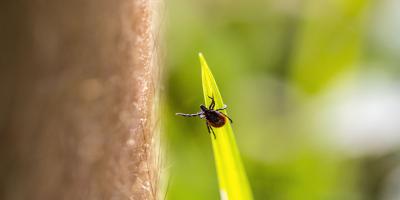How Common is Lyme Disease in New England?

It’s the first thing everyone worries about when they pull off a tick: Lyme disease. A tick-borne infection that starts with a telltale “bullseye” rash, Lyme disease is practically synonymous with tick bites. But is it really that common, especially in New England? Unfortunately, it is.
The Lowdown on Lyme Disease
New England is practically the epicenter of Lyme Disease in North America. In fact, the Centers for Disease Control and Prevention rank every New England state as “high incidence” for Lyme. The CDC puts that designation on only four other states -- two of which border New England (Virginia and West Virginia).
Why is there such a high concentration of Lyme disease in New England? To figure that out, let’s go back to where it all started, in Lyme, Connecticut.
In the late 1950s, a Connecticut mom named Polly Murray found it odd that her children, the neighbor children, and even the family dog all began to suffer from the same set of mysterious symptoms. These included rashes, migraines, recurring fevers and one other symptom that usually only happens to older adults: joint swelling and pain.
Soon, a spate of children and adults in the area were identified with what was first called Lyme arthritis. Doctors noticed most of these cases occurred in the summer and early fall, which coincided with another problem that had recently reared its head: ticks. Lyme, Connecticut hadn’t had a substantial tick problem until, in the 1970s, vast tracts of farmland were converted back into forests, creating the perfect habitat for the little parasites.
It’s no coincidence that Lyme disease originated in southern New England and continues to be a problem throughout the northeast to this day. The reason comes down to the primary vector species that carries Borrelia burgdorferi (the bacteria that causes Lyme disease) -- the black-legged deer tick.
Location, Location, Location
Deer ticks not only prefer wooded areas over farmland, they also need the northeast’s cooler, more humid climate to thrive. When deer ticks are exposed to high temperatures and low humidity, they die of dehydration. That’s why deer tick populations -- and rates of Lyme disease -- tend to fall the farther south you travel.
Other factors in recent years have led to an even greater increase of Lyme disease cases in New England. These include habitat range expansion, which is when a host animal -- like the deer that deer ticks are named for routinely feeding off of -- travels outside its typical range. Longer seasonal activity is also to blame, as winters haven’t been as cold for as long as in years past. Finally, more humans venturing into tick hot zones has increased human exposure overall.
It’s impossible to predict how likely any given deer tick is to be infected with Lyme disease. As little as 1% up to as much as 50% of any given tick population has it. Your best bet if you do venture out into the woods or other high-risk tick areas is to wear insect repellent, minimize skin exposure and always, always check yourself and your companions for ticks when returning. A Lyme-carrying tick must be attached for 36 to 48 hours before it can effectively transmit the disease, so the sooner you check, the better.
Are you fending off a tick problem in your neck of the woods? Check out our tick control and prevention page and request a free quote today.



